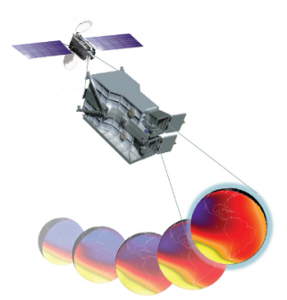
The Global-scale Observations of the Limb and Disk (GOLD) mission, part of the NASA Explorers Program, passed a rigorous examination on March 5th at the Goddard Space Flight Center in Maryland, enabling the mission to move into the final design and fabrication phase.
“The successful confirmation of GOLD means we can implement our plan to provide unprecedented imaging of weather in the upper atmosphere,” said Jeff Newmark, Interim Director for Heliophysics at NASA Headquarters in Washington, DC. “GOLD will improve our understanding of the upper atmosphere’s response to forcing from the Sun, the magnetosphere and the lower atmosphere.”
Launching in the fall of 2017, GOLD will be positioned in a geostationary orbit, ideal for imaging the Earth below. The instrument will make images of temperature and composition in the sun-lit thermosphere and of electron density in the nighttime ionosphere. By capturing the first global-scale images of conditions in Earth’s upper atmosphere on a cadence of 30 minutes, GOLD will provide critical data on subtle changes due to space weather events, according to Michael Hackman, LASP engineer and GOLD Program Manager.
Space weather events originate on the Sun with ejections of material and x-rays into space. When directed at the Earth, they cause geomagnetic storms that sometimes interfere with radio communication and disrupt GPS satellites, impacting everything from airline travel over the poles, to high tech farming and cell phone reception, just to name a few things.
“We just got one step closer to providing a whole new picture of our upper atmosphere’s response to space weather,” said Bill McClintock, GOLD Deputy Principal Investigator and LASP Planetary Research Scientist. “When you look at how our daily lives depend on technology, you see how the Earth’s space environment has become more important to us than ever before.”
GOLD Principal Investigator, Richard Eastes, from the University of Central Florida (UCF) Florida Space Institute (FSI), oversees the GOLD mission. UCF will be responsible for disseminating data products. The University of Colorado Boulder’s Laboratory for Atmospheric and Space Physics (LASP) is developing the instrument and is responsible for science operations. Other members of the GOLD team supporting the mission include the National Center for Atmospheric Research, the University of California at Berkeley, Computational Physics, Inc., and the National Oceanic and Atmospheric Administration.
Contacts
- Bill McClintock, GOLD Deputy Principal Investigator, mcclintock@lasp.colorado.edu or (303) 492-8407
- Michael Hackman, GOLD Program Manager, michael.hackman@lasp.colorado.edu or (303) 735-1236
- LASP Office of Communications and Outreach, epomail@lasp.colorado.edu
[addthis]



